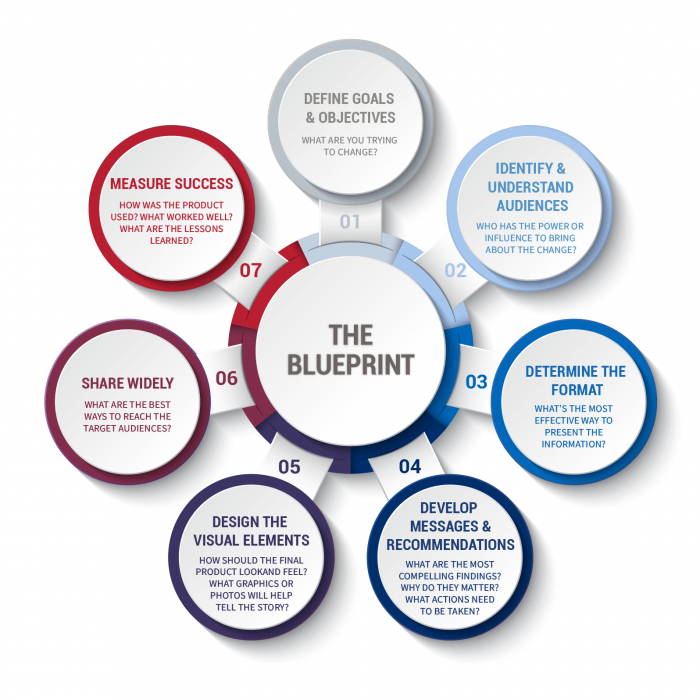A Blueprint for Strategically Communicating Research for Development Impact
RTAC
POSTED November 21, 2019
|General Information
Carolyn Rodehau, Senior Communications and Engagement Lead, RTAC and Alex Reed, Program Associate, Population Reference Bureau
One of the ways Research Technical Assistance Center (RTAC) supports evidence-based decisionmaking is by translating and synthesizing research into accessible and visually appealing communications products. RTAC uses a collaborative co-creation process with research teams to develop products that encourage the of use development research by policymakers, donors, program implementers, and other development partners. Our seven-step blueprint for strategically communicating research evidence is described below.

Step 1: Set communications goals and objectives
It is important to define what we are ultimately trying to achieve from the start. Through a series of guided discussions with research teams, we collaboratively establish an overarching communications goal and set of corresponding objectives. Possible communications objectives may include creating awareness, improving knowledge and understanding, encouraging investment, or influencing perspectives and attitudes.
Step 2: Define audiences
Here, the research team gets clear about who they need to influence. Together we distinguish their primary audiences – those who have the direct authority to achieve the desired goal – from their secondary audiences – those who can help influence key decisionmakers.
Step 3: Select most the useful format
Next, we work together chose the “right” type of communications product. Appealing and accessible formats that are useful to a range of stakeholders include factsheets, policy briefs, short videos, infographics, presentations, and case studies. When selecting the format, we consider the communication goals and objectives along with the potential preferences of target audiences regarding length, level of interactivity, and visuals.
Step 4: Craft key messages and action-oriented recommendations
Once we’ve reached agreement on format, it’s time to craft the key messages. This step involves identifying the most relevant and compelling data points, explaining their practical implications , and providing specific action steps the target audiences can take. Consensus building is an important feature in this step. In order to ensure the key messages and recommendations will resonate with key stakeholders, we strategically solicit input and feedback from the research team, USAID colleagues, and local partners.
Step 5: Package using visually appealing colors, graphics, and photos
Once the content of the product is finalized, we brainstorm with the research team about how the final product should look and feel. This involves determining the color palette, the types of photos and/or illustrations, and how to visualize key data points. Here, we also want to make sure that the photos and illustrations are contextually appropriate and that the data visualizations make the data easier to interpret and understand.
Step 6: Strategize for dissemination
Finally, the team strategizes and plans for dissemination. Here, the team determines the platforms and channels they will use to reach their target audiences. Dissemination tactics might include in-person events, one-on-one meetings, or social media and email campaigns.
Step 7: Assess the impact
Last but not least, we always encourage the research teams to track and measure their success and opportunities to improve in the future.
Ultimately, through this interactive process, RTAC delivers user-friendly communications products to equip decisionmakers with the information they need to put evidence into practice.
